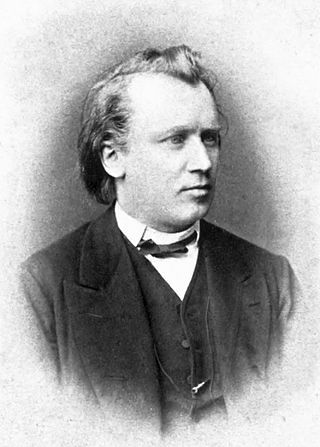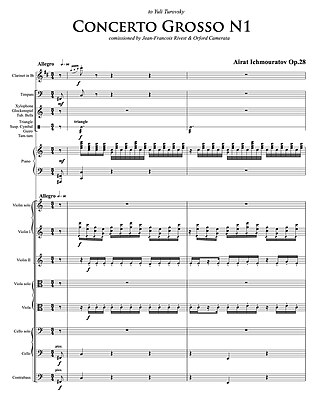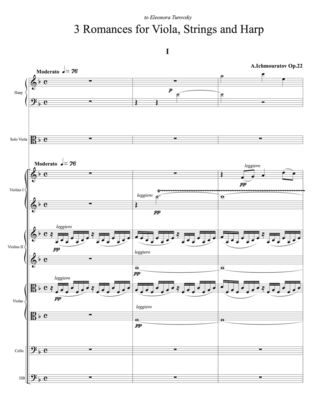
Ludwig van Beethoven's String Quartet No. 11 in F minor, Op. 95, from 1810, was his last before his late string quartets. It is commonly referred to as the "Serioso," stemming from his title "Quartett[o] Serioso" at the beginning and the tempo designation for the third movement.

The Symphony No. 2 in D major, Op. 36, is a symphony in four movements written by Ludwig van Beethoven between 1801 and 1802. The work is dedicated to Karl Alois, Prince Lichnowsky.
The String Quartet No. 2 is a string quartet in D major written by Alexander Borodin in 1881. It was dedicated to his wife Ekaterina Protopova. Some scholars, such as Borodin's biographer Serge Dianin, suggest that the quartet was a 20th anniversary gift and that it has a program evoking the couple's first meeting in Heidelberg. Of its four movements, the third movement "Notturno" is the most famous.
Antonín Dvořák's Serenade for Strings in E major, Op. 22 (B. 52), is one of the composer's most popular orchestral works. It was composed in just two weeks in May 1875.

The String Octet in E-flat major, Op. 20, MWV R 20, was written by the 16-year-old Felix Mendelssohn during the fall of 1825 and completed on October 15. Written for four violins, two violas, and two cellos, this work created a new chamber music genre. Conrad Wilson summarizes much of its reception ever since: "Its youthful verve, brilliance and perfection make it one of the miracles of nineteenth-century music." This was one of the first works of Mendelssohn to be very well received.
The String Quintet in E♭ major, Op. 97, B. 180, was composed by Antonín Dvořák during the summer he spent in Spillville, Iowa in 1893. It is a "Viola Quintet" in that it is scored for string quartet with an extra viola. It was completed in just over a month, immediately after he wrote his American String Quartet. Like the Quartet, the Quintet finely captures the inflection of Dvořák's Bohemian idiom with American inspirations. The Quintet was premiered by the Kneisel Quartet in New York on 13 January 1894 along with the second performance of the Quartet and very favorably reviewed, as comparable to Mozart. The reviewer noted that the Quintet was "of the kind about which a commentator may write a small volume without exhausting his admiration or fully describing their beauties".
The String Quartet No. 2 in A minor, Op. 13, was composed by Felix Mendelssohn in 1827. Written when he was 18 years old, it was, despite its official number, Mendelssohn's first mature string quartet. One of Mendelssohn's most passionate works, the A minor Quartet is one of the earliest and most significant examples of cyclic form in music.

The Piano Quartet No. 3 in C minor, Op. 60, completed by Johannes Brahms in 1875, is scored for piano, violin, viola and cello. It is sometimes called the Werther Quartet after Goethe's The Sorrows of Young Werther. The premiere took place in Vienna on November 18, 1875, to an anxious public. Richard Wagner and his wife Cosima were in attendance.
String Quartet No. 4 by Walter Piston is a chamber-music work composed in 1951.
Brian Manker is the Principal Cellist of the Montreal Symphony Orchestra in Montreal, Quebec, Canada, and cellist of the New Orford String Quartet and the Adorno Quartet. Manker has performed throughout North America as a member of the Harrington String Quartet, the Cassatt Quartet, and the Atlanta Chamber Players.
The String Quartet in D major is the only string quartet composed by César Franck. The work was written from 1889 to 1890.

Airat Rafailovich Ichmouratov born 28 June 1973, is a Volga Tatar born Russian / Canadian composer, conductor and klezmer clarinetist. He is a founding member and clarinetist of award-winning Montreal-based klezmer group Kleztory and invited professor at Laval University in Quebec, Canada.

Elvira Rafailovna Misbakhova is a Volga Tatar born Russian / Canadian violist and violinist. Misbakhova is presently Associate Principal Viola at the Orchestre Métropolitain of Montreal, Trois-Rivières Symphony Orchestra and the Longueuil Symphony Orchestra.

Gabriel Fauré's Piano Quartet No. 2, in G minor, Op. 45, is one of the two chamber works he wrote for the conventional piano quartet combination of piano, violin, viola and cello. It was first performed in 1887, seven years after his first quartet.

Airat Ichmouratov's Octet in G minor, Op. 56, was composed in December 2017. It was commissioned and premiered by Saguenay and Lafayette String Quartets on 13 January 2018 at Fanny Bay Hall, Fanny Bay, British Columbia, Canada. The Octet was inspired by Stefan Zweig's novella "Letter from an Unknown Woman" and bears the same name. In November 2018 composer made an arrangement of the Octet for string orchestra and it was recorded by Belarusian State Chamber Orchestra with Evgeny Bushkov as a conductor and was released by Chandos Records. The string orchestra version was first time publicly performed by the Belarusian State Chamber Orchestra with Evgeny Bushkov as a conductor on March 13, 2019 in Minsk, Belarus.

The Symphony in A minor, "On the Ruins of an Ancient Fort", Op. 55, was composed by Airat Ichmouratov in 2017 with support by Longueuil Arts Council. It was premiered in Longueuil City on 28 September 2018 by Longueuil Symphony Orchestra under the baton of French-Canadian conductor Marc David. Ichmouratov's Symphony seeks to recreate the vitality of Longueuil, a city on the south shore of the St. Lawrence River, from its beginnings as an outpost of New France to the present day.

The Viola Concerto No. 1, Op. 7, was composed by Airat Ichmouratov in 2004. It was commissioned and premiered by Elvira Misbakhova, a Canadian violist, today the principal viola of Orchestre Métropolitain, who was in 2004 a student at University of Montreal and was looking for new romantic viola concerto for her Doctoral program recital. Concerto was premiered at Claude Champagne Concert Hall in Montreal, Canada on 24 February 2005 by students of University of Montreal under the baton of composer Airat Ichmouratov.

Airat Ichmouratov's Concerto Grosso N1, Op. 28, was composed in 2011. It was commissioned and premiered on 15 July 2011 by French – Canadian conductor Jean-François Rivest and Orford Camerata at Orford Art's Centre, Orford, Canada. Ichmouratov himself was performing solo clarinet part as well on the recording of Concerto Grosso N1, that was released on Chandos in 2019.

Airat Ichmouratov's Three Romances for Viola, Strings, and Harp Op. 22, was composed during the summer of 2009. Ateş Orga stated that Three Romances are an affectionate character portrayal of Eleonora Turovsky (1939–2012) to whom the composition is dedicated and was written as a birthday gift. It was first performed at a surprise birthday concert at University of Montreal on 23 September 2009 by her pupils.

The Piano Concerto, Op. 40, is a work for piano and orchestra completed by Airat Ichmouratov between 2012 and 2013. Composition remained untouched for a span of ten years until the composer crossed paths with a soloist, Montreal-based pianist Jean-Philippe Sylvestre. Sylvestre's keen enthusiasm for performing the concerto, coupled with his ability to "do it justice and add finishing touches," as described by the composer, led to the revival of the piece. The Piano Concerto was recorded by Chandos on April 19–20, 2022, at St. Luke's in London, with Jean-Philippe Sylvestre as the soloist and the London Symphony Orchestra under the baton of the composer. Its first public performance took place on May 1, 2024, at the Palais Montcalm in Quebec City, with Sylvestre as the soloist, accompanied by the Quebec Symphony Orchestra under Ichmouratov.


















